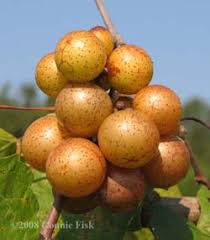 |
| Carlos |
Last fall 4 types of muscadine grapes were planted on sturdy wooden and wire trellises. The vines were flush with leaves and grapes when Irene came through. Even though they are in a fairly exposed location at the Arboretum they survived with just a few leaning posts and some grapes blown to the ground. Before the storm, the first to ripen were the Nesbitts, a black colored grape. The other varieties we have, Carlos (bronze colored and the leading variety grown in NC), Higgins (pink/bronze colored), and Hunt (dark purple colored), are all ripening into nice sweet grapes thanks to the sunny days, drier air, and warm temperatures. So far 37 pounds of grapes have been donated to Greenville's Food Bank and it is expected that many more pounds will be picked throughout September.
According to NCSU Horticultural Leaflet
Muscadine Grapes in the Home Garden, muscadines are well suited for growing in our area. Additionally, it states that
"Muscadines grapes, (
Vitis rotundifolia, or alternatively,
Muscadiniana rotundifolia) are often referred to as scuppernongs. Muscadine is native to the Southeastern United States and has been cultured for more than 400 years. It was first known as the ‘Big White Grape’, and was later named ‘Scuppernong’ after the area in
which it was found. With time, the name scuppernong became generic with all bronze muscadines, regardless of actual variety name. However, this is incorrect nomenclature, since ‘Scuppernong’ is only one of many cultivars of muscadine grapes."
An extensive brochure on how to get started can be found here:
Muscadine Grape Production Guide. You may also contact the Extension Master Gardeners (see right side column 'Ask a Master Gardener' for how to do that) if you have more questions.
